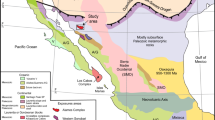Abstract
The Sesia-Lanzo Zone is a polymetamorphic unit containing Hercynian granulite relics overprinted by eclogite and greenschist facies metamorphism and deformation during the Alpine orogeny. Different parts of the unit record different stages on the P-T-deformation evolution, allowing multi-system isotopic studies to unravel the precise timing of the metamorphic history. New Rb–Sr white mica and U–Pb sphene data constrain the age of eclogite facies metamorphism and deformation to 60–70 Ma. This substantially alters the common view of early- to mid-Cretaceous eclogite facies metamorphism in this unit. The new results are more consistent with the established geotectonic framework for the Alpine orogeny, since they do not require a prolonged period of depressed geothermal gradient at a time when the region was in extension. It is also more concordant with recent studies of other units that demonstrate post-Cretaceous high-pressure metamorphism. Step-heated 40Ar–39Ar analysis of phengites yields good plateaux giving ages older than the corresponding Rb–Sr age. Such anomalously high ages indicate the presence of radiogenic argon-rich fluids in the grain boundary network under the fluid/pressure conditions acting during this high-pressure metamorphic event. The U–Pb sphene ages are variable in polymetamorphic rocks, and show inheritance of older Pb or sphene crystals into the high-pressure event. Two monometamorphic assemblages yield concordant ages at 66±1 Ma, reflecting crystallisation of the eclogite facies assemblage. The Gneiss Minuti Complex (GMC) lies structurally below the Eclogitic Micaschists, and its pervasive greenschist facies fabric yields tightly clustered Rb–Sr white mica ages at 38–39 Ma. This greenschist event did not affect the majority of the EMC. The 40Ar–39Ar ages of micas formed at this time were very disturbed, whereas micas surviving from an earlier higher pressure assemblage had their 40Ar–39Ar system reset. The greenschist event did not strongly affect U–Pb systematics in Hercynian age sphenes, suggesting that the GMC did not uniformly suffer an eclogite facies metamorphism during the Alpine cycle, but was juxtaposed against the EMC later in the orogeny. This model still requires that the locus of deformation and metamorphism (and possibly fluid flux) moved outboard with time, leaving the Sesia-Lanzo basement as a shear-bounded unreactive block within the orogenic wedge.
Similar content being viewed by others
Author information
Authors and Affiliations
Additional information
Received: 12 October 1995/Accepted:25 June 1996
Rights and permissions
About this article
Cite this article
Inger, S., Ramsbotham, W., Cliff, R. et al. Metamorphic evolution of the Sesia-Lanzo Zone, Western Alps: time constraints from multi-system geochronology. Contrib Mineral Petrol 126, 152–168 (1996). https://doi.org/10.1007/s004100050241
Issue Date:
DOI: https://doi.org/10.1007/s004100050241




